How to eliminate a leak in the heating pipe: saving
In properly designed modern heating systems, in the manufacture of which polymer parts were used, the formation of leaks, as a rule, is completely excluded. But the owners of old climate networks, the material for which served as steel, often wonder how to seal the leak in the heating pipe. The information below is intended for them.
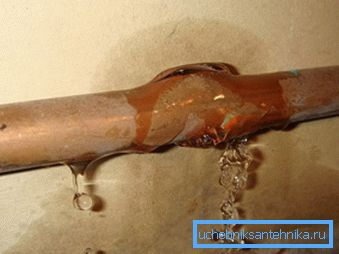
Fight against depressurization of the heating network
Causes of leaks and their places of formation
Steel pipe has many advantages:
- low price;
- high strength;
- the ability to transport water with a temperature above 100 degrees Celsius;
- availability and durability.
However, it has one major drawback - susceptibility to corrosion. Rust eventually corrodes the material and leads to the formation of a through hole through which the coolant flows.

Plastic pipes help to avoid leaks. They are quite suitable for the installation of individual climate networks (including their own hands) and do not rust when exposed to moisture and air.
The foregoing does not mean that polymer heating systems never leak.
It may occur in the following cases:
- Wrong material was selected. For example, a polypropylene pipe used to transport cold water is used. In this case, after the coolant is supplied, the parts melt, swell and burst, and the heating system becomes completely unusable, forcing it to be upgraded from scratch.
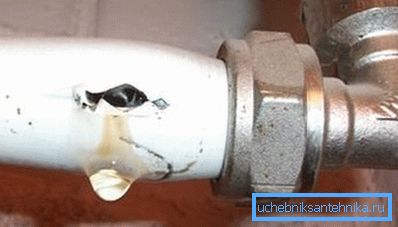
- Violated installation instructions. Incorrectly soldered or screwed fittings. It is necessary to strictly adhere to the prescribed sequence of actions: stripping the end face, heating the material, screwing in or pressing in fittings for pipes, and so on.
Note! Even such a trifle as improperly chamfering can be a problem. The sharp end of the pipe can “clean off” the plastic layer inside the coupling, which will eventually lead to depressurization.
Most often, leaks of the heating system are formed:
- on smooth sections of the pipeline;
- in places of threaded connection of individual parts;
- at the junction of pipes and fittings used;
- between separate sections of radiators.

Elimination methods
The choice of how to deal with the problem that has arisen depends on where the heating pipe is flowing. In any case, you should know that the methods described here are a temporary solution to the problem. As soon as you have the opportunity, you must urgently replace the damaged area, part, or completely upgrade the climate network.
For convenience of presentation, all methods for eliminating leaks are collected in a table and grouped according to the places of their formation.
| Way | Description |
| Straight pipe section | |
| Rubber hose clamp | It is necessary to take a small piece of soft rubber (for example, a part of an old bicycle chamber), tightly wrap it on the pipe section where a leakage has occurred, and fix it with a special clamp or a piece of steel wire. The width of the wound rubber tape should be 1-2 cm more than the damaged area. |
| Factory bandage | In this case, special repair kits are used to seal the pipe, which are sold in specialized stores. They are clamps of the appropriate diameter and width with special sealing rings. Mounting the bandage is not difficult. You just need to put it on the damaged pipe and tighten the nut with the bolt all the way. |
| Threaded connection | |
| Factory bandage | Here it is necessary to use the same repair kit as in the previous case, however, the ring in the kit should be replaced with a rubber tape. It will lay tight on the joint, compensating for the difference in diameters. Although the clamp will be fixed unevenly, still the hole is sealed quite reliably. |
| Rock salt and bandage | The method is the simplest and cheapest, but its reliability leaves much to be desired. It can be used in emergency cases when there are neither clamps nor a piece of rubber on hand. The procedure is simple: you need to wrap the pipe with a medical bandage mixed with salt. After wetting, it petrifies and seals the hole. |

Note! Before closing the heating pipe with a bandage and salt, it is advisable to temporarily (for a short time) shut off the coolant supply. Otherwise, the fluid circulating through the pipes under high pressure may erode your bandage before the salt petrifies.
Elimination of leaks at the joints of pipes is performed in the same way as the temporary repair of threaded connections.
Modern methods of struggle
Engineering thought does not stand still and, in addition to the well-known old-fashioned ways, new ones appear. In particular, it is possible to eliminate a leak in the heating pipe with a metal polymer, which is sold in a specialized shop.
The procedure in this case is as follows:
- The leak is carefully cleaned from the paint coat.
- Preparing a metalpolymer. To do this, the purchased two-component composition is mixed in the proportions indicated on the packaging. Be sure to use a spatula or other suitable tool, and also protect your skin with rubber gloves.
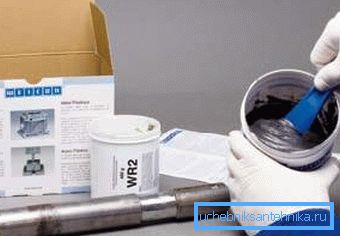
- The prepared composition is thoroughly rubbed into the pipe section., where a crack or hole has formed.
- After that, apply a second layer of paste on top.. It is necessary to make the repair composition cover both the hole itself and 2-3 centimeters around it. At the end of the procedure should wait for the full polymerization of the paste.
- Then using sanding paper, the surface of the pipe is trimmed from excess polymer.
- Pre-cooked finishing compound is applied to this area.. It is also prepared according to the instructions on the package. You need to cover a larger area - a radius of 3-4 centimeters.
Tip! Finishing curing layer must be carefully and carefully smoothed. On this depends on the appearance of the pipe after the completion of the work, as the finishing sanding paper should not be made.
- After complete freezing of the paste, the pipe can be painted..
This method of eliminating leaks, although the most time-consuming, allows for maximum reliability. The pipe will serve you until you leak elsewhere or until you decide to upgrade the heating system.
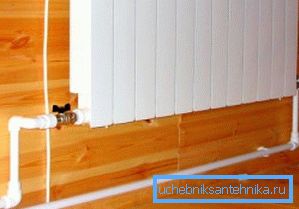
Elimination of leaks in the radiator
Sometimes a leak is formed between sections of the battery. This is due to the failure of the gasket, sealing the joint. If you cannot change the heating appliance, use the instructions on how to temporarily fix a leak.
This is done as follows:
- With the help of valves, it is necessary to block the access of the heat carrier to the apartment or to the heating radiator, and then dry the leakage place.
- Prepare an epoxy glue (mix two of its components) and apply on a piece of cloth with a width of 10 to 40-50 cm long.
- After that, wrap the patch around the problematic connection in several layers.
Tip! It is possible to switch on the coolant supply only after the epoxy composition is completely cured.
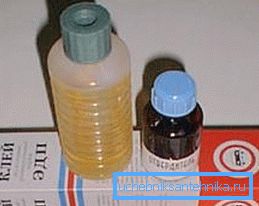
Conclusion
Whichever leak remediation method you choose, they are a temporary fix. To increase the reliability of the heating system is possible only by replacing pipes and radiators. You can learn how to do this from the video below.